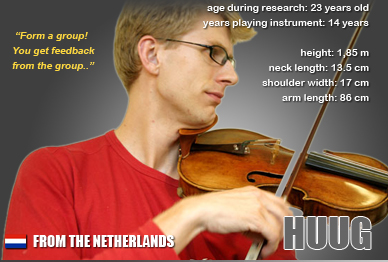3. Making the change
Equipment changes
Before this research I had often tried to change my equipment, trying this and that: a Wolf shoulder rest, and a Kun, etc. I also tried different chin rests, but with the chin rests I only tried different positions, over the tailpiece, or to the side, but I had not changed the height of the chin rest on my own.
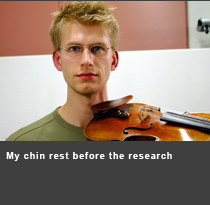
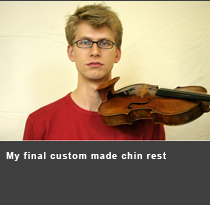
At the beginning of the research I had a normal Kun shoulder rest and a chin rest with a very big cup. The surface of the chin rest was so big that when I bent my head towards the chin rest, the cup also touched my left ear! The chin rest was not very high, so I had to compensate for the lack of height by contracting my neck and shoulder.
Shortly after starting the research I got a chin rest from the testing kit that was 2 cm higher than my old model. I took off my shoulder rest and used instead a red rubber Eprex ball cut in half. I learned a lot from using the Eprex red ball in place of a shoulder rest, because I could let the violin rest on my collar bone. I covered this half ball with anti-slip rubber and put it under my sweater, with another piece of anti-slip rubber over my clothing on top of this, and my violin on top. This helped keep the instrument from sliding.
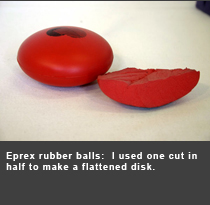
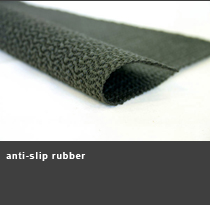
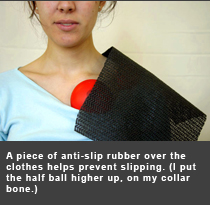
With this new set-up I went on tour right away with the National Youth Orchestra. At first I had a very strong reaction in my body, especially after the first weekend of rehearsals, and I thought: “Perhaps I shouldn’t do this orchestra tour.” I had pain in my shoulder and neck at first, but then I went on tour anyway, and played pretty much without pain with very few problems.
The ball did dampen the sound a bit and it wasn’t really so handy to have under your clothes the whole time because it didn't stay in place. So, towards the end of the research period I started using a Kun shoulder rest again, this time the expensive one made of wood. Now, even with a shoulder rest, I have the violin on my collar bone, which I never had at the beginning. Almost all of us play again with a shoulder rest, but use it differently. I couldn't find a shoulder rest that touches my breast bone, so I use the support of the rest only on my collar bone. It sits a bit on the chest muscle, but I just let it rest there and don’t press.
Half way through the research I got a chin rest from the testing kit that had the cup positioned partly to the left of the tailpiece. My bowing became freer because the change in violin position gave me more room to bow.
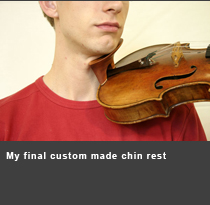
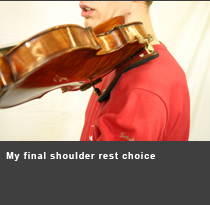
At the end of the project I got a custom made chin rest that suited me very well. I played a successful final exam with this equipment and it still feels good as it is.
Playing technique
The biggest change I made was that I changed the position of the instrument. It now sits on my collar bone, and my head is up, not pulled down. Also, the fingerboard is more to the left, giving me room to bow. This means that the bow is in a different relation to the string, so you have to practice your bowing. Also, you have the tendency to play false, so you need to take time to let your left hand get used
to your instrument again.
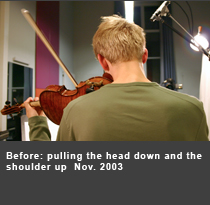
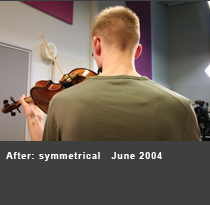
During the research, I wasn’t really busy with how to stand, or where my head is. But because you hear it often during the research, and because you have an Alexander lesson every week, things change by themselves. I stand more stable and on both feet, so that I am balanced on both legs. I also stand straighter, and I don’t pull my head down, and I don’t pull my shoulders up, so I am more symmetrical. As a result, I bow much more easily.
The biggest difficulty when using new equipment is that you still have old habits. When I first received the higher chin rest it felt way too high, but I got used to it really fast. Previously I pulled my head down to play and you really can’t do that any more when you have a chin rest that is raised 2 cm! I didn’t, in any case, ever feel that I “went crazy” from the changes; it wasn’t that bad. A week before the youth orchestra tour I was thinking: “Shall I do this or not?” I thought if I didn’t do the orchestra project, I could use the Christmas vacation to work restfully on the equipment changes. I knew that on such a tour you have to play six or more hours a day, and I didn’t know if I dared to do that at that point. But I went ahead and did the audition, and when I was accepted, I just went on the tour. I don’t regret it because I had no physical complaints after all, and it was a lot of fun. I think that it actually helped me to get used to the new equipment more quickly. Because I had to play the whole time I had to get used to it, so I think it saved me time in the end.
Framework
I think that in general I've got a clearer of sense of the spatial relationship between myself and the violin. I have a kind of "framework". If I need to find a certain note now I can just go there because I know where it is.
I have really big hands, so it is easy for me to go to high notes just by reaching, without bringing my hand around the violin. But if you just reach, you bend and stretch your wrist to the outside and that gives a lot of tension. Then, if you are nervous, your left hand will shake. So, I try to bring my hand around the violin for position changes so that I am really in position when I have completed the shift. Letting go some with my chin has also helped my left hand technique.
As for my bow hand: the shaking of the bow, and unwanted bouncing on long notes is almost gone, and it is much easier to make a long, constant tone.

